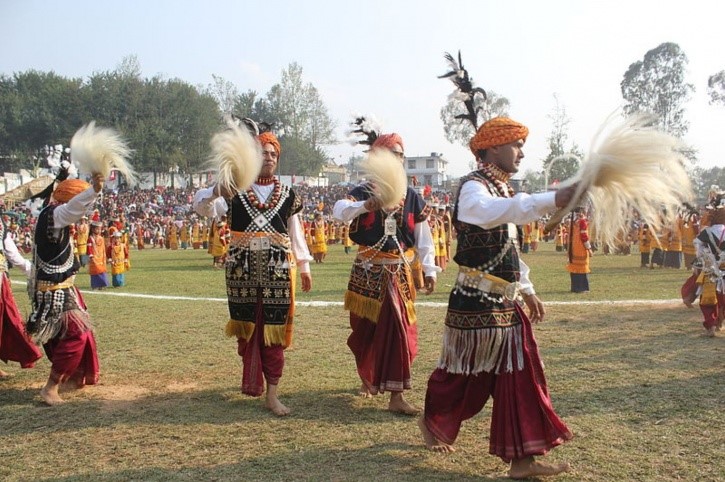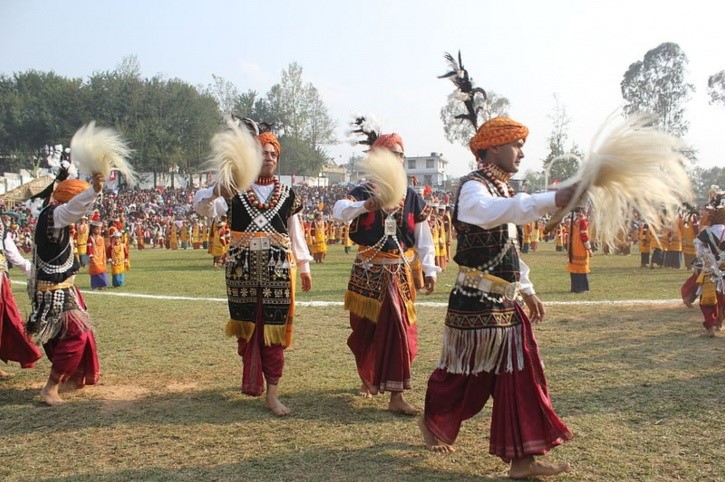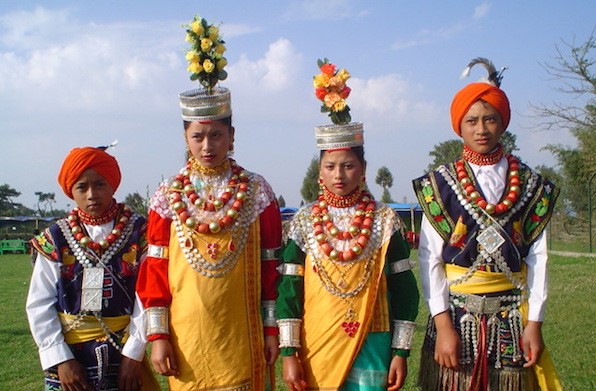KHASI TRIBE, MEGHALYA

(Source)
The Khasi tribe is a pretty peace loving tribe and they are named after the language they speak: Khasi language. While most of the Khasis follow their tribal religion, there are many converts who have taken up other religions like Christianity and Islam. One thing that makes the tribe unique is that they are a matrilineal tribe, which means they carry on the maternal tradition. The children's surnames are based on the mother's lineage and not the fathers. Also, it is the mother who inherits the property and not the father. Also, Khasi tribals do not prefer arranged marriages. In case of a divorce, the woman has complete freedom. Her choice cannot be questioned and she owns the children and properties. The property post death/conflicted property always goes to the youngest daughter. Women, thinking of converting to the Khasi tradition? Another cool thing about them is their divorce method. While the younger generation does resort to courts, most of the Khasis follow the traditional method. The husband hands the wife 5 paise which the wife returns after adding 5 of her own. The coins are then given to the village elder who throws them away. And done! Divorce complete!(Source)
INTRODUCTION
The Khasi people are an indigenous ethnic group of Meghalaya in north-eastern India with a significant population in the bordering state of Assam, and in certain parts of Bangladesh. The Khasi people form the majority of the population of the eastern part of Meghalaya, and is the state's largest community, with around 48% of the population of Meghalaya. They are the only Mon-Khmer speaking people in South Asia. A cultural tradition of the Khasi people is that they follow the matrilineal system of descent and inheritance. Under the Constitution of India, the Khasis have been granted the status of Scheduled Tribe.
Khasi Mythology
Khasi mythology traces the tribe's original abode to 'Ki Hynñiewtrep ("The Seven Huts").[2] According to the Khasi mythology, U Blei Trai Kynrad (God, the Lord Master) had originally distributed the human race into 16 heavenly families (Khadhynriew Trep).[3] However, seven out of these 16 families were stuck on earth while the other 9 are stuck in heaven. According to the myth, a heavenly ladder resting on the sacred Lum Sohpetbneng Peak (located in the present-day Ri-Bhoi district) enabled people to go freely and frequently to heaven whenever they pleased until one day they were tricked into cutting a divine tree which was situated at Lum Diengiei Peak (also in present-day Ri-Bhoi district), a grave error which prevented them access to the heavens forever. This myth is often seen[by whom?] as a metaphor of how nature and trees, in particular, are the manifestation of the divine on Earth and destroying nature and trees means severing our ties with the Divine. Like the Japanese, the Khasis use the rooster as a symbol because they believe that it was he who aroused God and also humbly paved and cleared the path for God to create the Universe at the beginning of time. The rooster is the symbol of morning marking a new beginning and a new sunrise
Language
The Khasi language is classified as part of the Austroasiatic language family. According to Peter Wilhelm Schmidt , the Khasi people are related to the Mon-Khmer people of South East Asia. Multiple types of research indicate that the Austroasiatic populations in India are derived from migrations from Southeast Asia during the Holocene period. Many of the words are similar to other Austroasiatic languages such as Palaung and Khmer language:
-
Tiger- Khla (Both Khasi &Khmer).
-
To fly- Her in [Khasi], haer in [Khmer]
-
kpoh in [khasi], poh in [khmer], bung in Vietnamese.
-
New-'Thymme or thymmai' in Khasi , thmei or thmai in [Khmer], moi in Vietnamese.
-
Year- Snem in [Khasi] , chnem in [khmer], nam in Vietnamese.
-
Far- jngai in [Khasi], chngay in [Khmer] and Many More
There are also similar to those in Sino-Tibetan languages, such as nga meaning "I," which is the same in Tibetan, Burmese, and Old Chinese as it is in Khasi. Traces of connections with the Kachin tribe of North Burma have also been in the Khasis. The Khasi people also have their own word for the Himalayan mountains which is "Ki Lum Mankashang" which means that at one point in time, they did cross the mighty mountains. Therefore, all these records and their present culture, features, and language strongly show that they also have a strong Tibeto-Himalayan- Burman influence. The word "Khas" means hills and they have always been people of cold and hilly regions and have never been connected to the plains or arid regions. This nature-loving tribe calls the wettest place on Earth their home. The village of Mawsynram in Meghalaya receives 467 inches of rain per year.
Primarily an oral language, they had no script of their own, they used the Bengali script until the arrival of the Welsh missionaries. Particularly significant in this regard was a Welsh evangelist, Thomas Jones, who had transcribed the Khasi language into the Roman Script.
Dress
The traditional Khasi male dress is a Jymphong, a longish sleeveless coat without collar, fastened by thongs in front. Nowadays, most male Khasis have adopted western attire. On ceremonial occasions they appear in a Jymphong and sarong with an ornamental waist-band and they may also wear a turban. The traditional Khasi female dress is called the Jainsem or Dhara, both of which are rather elaborate with several pieces of cloth, giving the body a cylindrical shape. On ceremonial occasions, they may wear a crown of silver or gold. A spike or peak is fixed to the back of the crown, corresponding to the feathers worn by the menfolk. The Jainsem consists of two pieces of material fastened at each shoulder. The "Dhara" consists of a single piece of material also fastened at each shoulder
Marriage
The Khasis are, for the most part, monogamous. Their social organisation does not favour other forms of marriage; therefore, deviation from this norm is quite rare. Young men and women are permitted considerable freedom in the choice of mates. Potential marriage partners are likely to have been acquainted before betrothal. Once a man has selected his desired spouse, he reports his choice to his parents. They then secure the services of a mediator to make the arrangements with the woman's family (provided that the man's clan agree with his choice). The parents of the woman ascertain her wishes and if she agrees to the arrangement her parents check to make certain that the man to be wed is not a member of their clan (since Khasi clans are exogamous, marital partners may not be from the same clan). If this is satisfactory then a wedding date is set.
Divorce (with causes ranging from incompatibility to lack of offspring) is easily obtainable. This ceremony traditionally consists of the husband handing the wife 5 cowries or paisa which the wife then hands back to her husband along with 5 of her own. The husband then throws these away or gives them to a village elder who throws them away. Present-day Khasis divorce through the Indian legal system.
The type of marriage is the determining factor in the marital residence. In short, post marital residence for a married man when an heiress (known as Ka Khadduh) is involved must be matrilocal (that is, in his mother-in-law's house), while post-marital residence when a non-heiress is involved is neolocal. Generally, Khasi men prefer to marry a non-heiress because it will allow them to form independent family units somewhat immune to pressures from the wife's kin. Traditionally (though nowadays rule is not absolutely true), a Khasi man returns to his Iing-Kur (maternal home) upon the death of his spouse (if she is a Khadduh and they both have no children). These practices are the result of rules governing inheritance and property ownership. These rules are themselves related to the structure of the Khasi Kur (clan system)
Traditional polities
The traditional political structure of the Khasi community is democratic in nature. In the past, the Khasis consisted of independent native states called Syiemships, where male elders of various clans under the leadership of the Chief (called U Syiem) would congregate during Durbars or sessions and come to a decision regarding any dispute or problem that would arise in the Syiemship. At the village level, there exists a similar arrangement where all the residents of the village or town come together under the leadership of an elected Headman (called U Rangbah Shnong), to decide on matters pertaining to the locality. This system of village administration is much like the Panchayati Raj prevalent in most Indian States. There were around 25 independent native states on record which were annexed and acceded to the Indian Union. The Syiems of these native states (called Hima) were traditionally elected by the people or ruling clans of their respective domains. Famous among these Syiemships are Hima Mylliem, Hima Khyrim, Hima Nongkhlaw, amongst others. These Syiemships continue to exist and function till today under the purview of the Khasi Hills Autonomous District Council (KHADC), which draws its legal power and authority from the Sixth Schedule of the Constitution of India.
Religion



